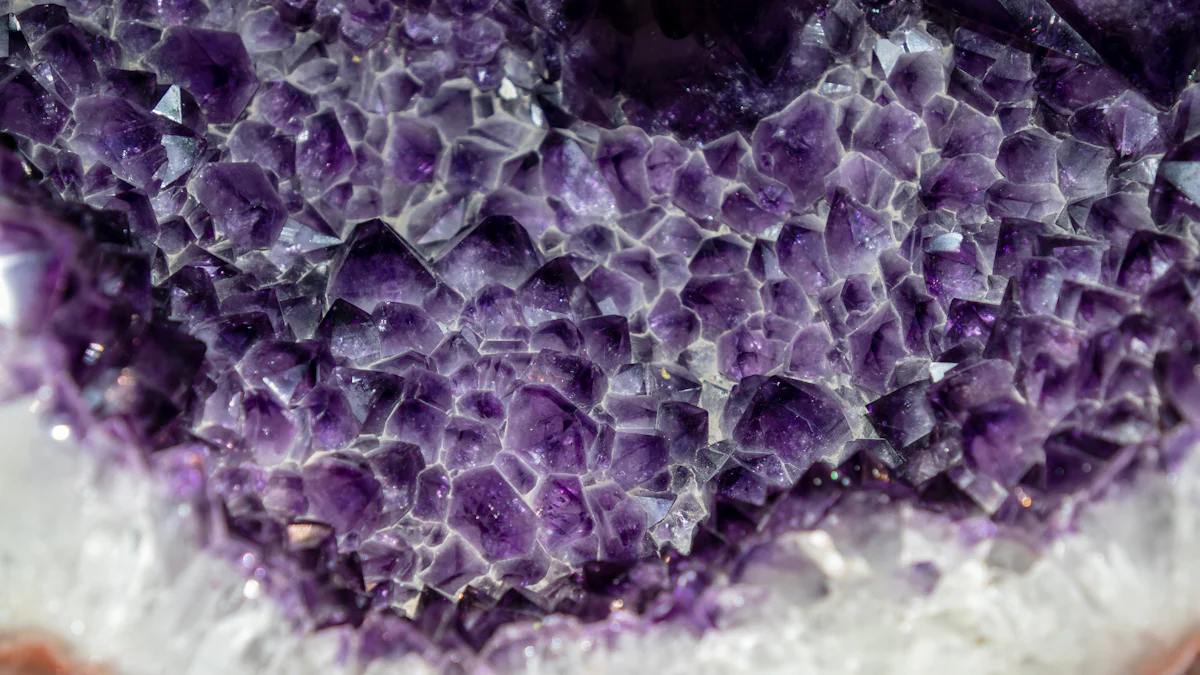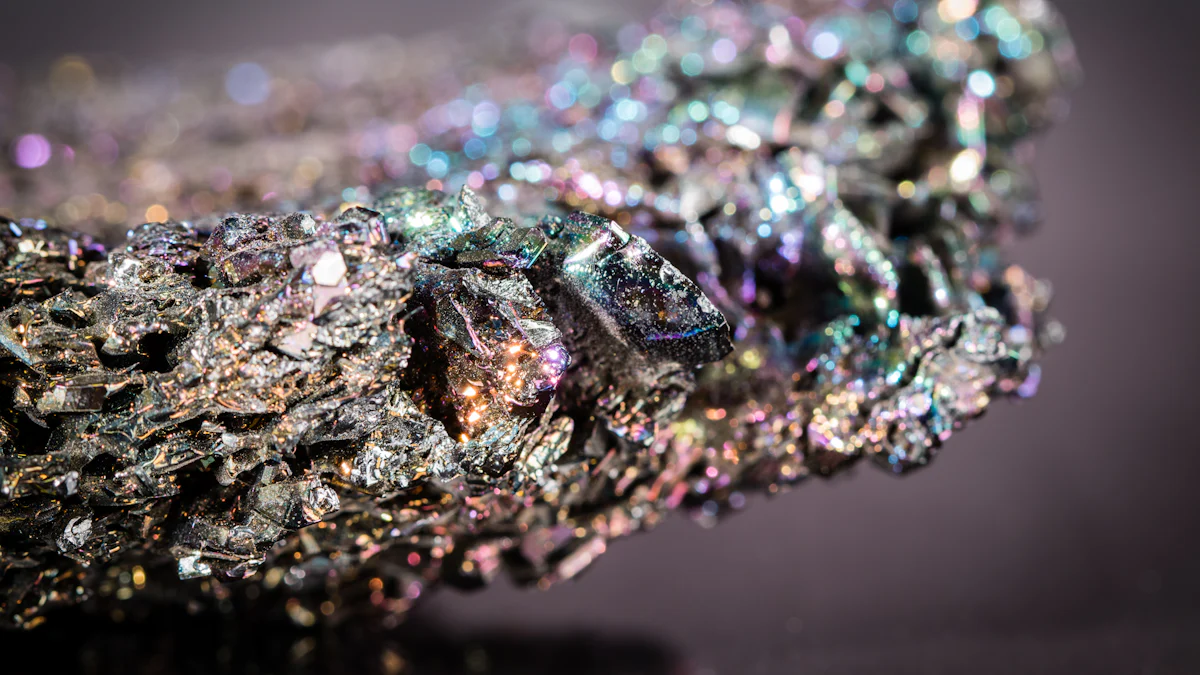2025年、炭化ケイ素はなぜ高いのか?

2025年のシリコンカーバイドの高騰コストは、先進産業における重要な役割を果たしています。 ザ・オブ・ザ・ 自動車・半導体分野、によって運転される 電気自動車 そして、 renewable energy、かなり高められた要求があります。 市場は、2024年に$1.672億から$4.863億に及ぼすこの傾向は、2029年までに増加しました。 しかし、限られた生産能力と創造のエネルギー集中プロセス silicon carbide coated susceptors 高価格に貢献します。 その他、ご利用にあたって sic coated susceptors 製造では効率性を高めますが、生産コストに追加します。 革新のような sic coating パフォーマンスを最適化し、まだスケーリングすることは挑戦を続けています.
要点
- 炭化ケイ素 電気自動車やグリーンエネルギーに必要とされているため、コストアップ。 市場は2029年までに大きく成長します.
- 純粋な原料はあまりなく、硬くなっている。 シリコンカーバイドを高価に.
- シリコンカーバイドのコーティングツールは、半導体をより速く、より良いものにするのに役立ちます。 工場のコストも削減します.
- 新技術 世界中の工場は価格が下がる可能性があります.
- エコな方法で炭化ケイ素を作ることは重要です。 汚染を削減し、より良いリサイクルを目指した新しいアイデア.
シリコンカーバイドの挑戦

原料の希少性
高純度シリコンと炭素供給の制限
シリコンカーバイドの生産は、高い純度のシリコンと炭素源に依存しています。 これらの原料は最終製品の性能および耐久性を保障するために厳しい品質基準を満たしなければなりません。 これらのリソースの希少性は、供給チェーンでボトルネックを作成し、メーカーが成長する需要を満たすのは困難です。 この制限は、市場における炭化ケイ素のコストと可用性に直接影響します.
原料サプライチェーンに影響を与える地政的要因
地政性張力は更に原料の供給を複雑にします。 豊富なシリコンと炭素が抱える多くの地域は、輸出制限や政治的不安定性に直面し、世界的なサプライチェーンを破壊します。 これらの課題は、シリコンカーバイドの生産の全体的な費用に加え、多くの場合、より高いコストで代替ソースを求めるためにメーカーを強制します.
複雑な製造プロセス
生産のための高いエネルギー条件
炭化ケイ素を作り出すことは消費するAcheson方法のようなエネルギー集中プロセス、を含んでいます 炭化ケイ素のトンごとの電気の約6.5 MWh. . 主にアーク炉を熱することから非常に高温に集中するエネルギー要求。 半導体等級の炭化ケイ素のために、エネルギー条件は次テーブルで示されるようにより高くです:
| 年 | エネルギー条件(MWhel/tSiC) | 低温度熱需要(MWhth/tSiC) | ダック 単位エネルギー条件(kWhel/tSiC) |
|---|---|---|---|
| 2030 | 26.2 | 3.7 | 548 |
| 2040 | 24.9 | 3.1 | 495 |
| 2050 | 24.2 | 2.7 | 444 |
エネルギー消費量を削減する努力は続いていますが、高エネルギー需要は重要なコストドライバーのままです.
半導体グレードの炭化ケイ素の品質管理に必要な精密
半導体グレードの炭化ケイ素は、優れた精度が求められます。 プロセスは、 原料の選択、鋳造物、乾燥、焼結および品質管理を含む多数のステップ、. . 各ステップは重要な適用の物質的な性能を保障するために厳密な基準を満たしなければなりません。 この精度は、生産の複雑さとコストを増加させます.
スケール生産コスト
高品質の炭化ケイ素を製造できる限られた施設数
炭化ケイ素の生産のスケールアップは重要な挑戦を示します。 少数の設備は農産物に必要な高度装置および専門知識を所有しています 高品質のシリコンカーバイド. . これらの施設の専門性は、グローバル生産能力を制限し、さらにコストを削減します.
高度の製造業装置に必要な高い資本投資
生産設備の確立またはアップグレードには、実質的な資本投資が必要です。 シックコーティングされたスセプターを製造するために使用されるような高度な製造装置は、重要な財務リソースを要求します。 これらの投資は、製造効率を維持し、半導体や電気自動車などの業界における炭化ケイ素の需要の高まりを満たすために必要です.
シックコーティングされた感受性の役割
高温製造工程における重要性
炭化ケイ素上塗を施してある感受性 特に半導体業界において、高温製造プロセスにおいて重要な役割を果たしています。 とりあえず 優秀な熱安定性 金属組織化学蒸着(MOCVD)のようなプロセスのために不可欠である極端な条件下で一貫した性能を保証します。 コーティングは酸化から保護し、高温への長期暴露の間に感受性の完全性を維持します。 この安定性により、製造業者は薄膜成長、高品質のエピタキシャル層を製造するための主要な要件よりも精密な制御を達成することができます.
SiCコーティングはまた、材料インタフェースと表面特性を高め、基板と成長フィルム間の相互作用を改善します。 これは、先進的な半導体デバイスにとって重要な成長モードと高品質インターフェイスにつながります。 また、塗装は不純物の汚染を最小限に抑え、最終製品の信頼性と性能を保証します。 これらの属性は、現代の製造環境に欠かせない炭化ケイ素系スセプターを作る.
生産の効率および費用管理への貢献
炭化ケイ素上塗を施してある感受性器は半導体の製造の生産の効率および費用管理をかなり改善します。 とりあえず 熱安定性および化学抵抗 欠陥の可能性を減らし、より高い収量とより良い製品品質につながる。 エピタキシャル成長プロセスの精密な制御を可能にすることにより、これらの受容体はエネルギー使用を最適化し、デバイス性能を向上させます。 運用コストを下げるだけでなく、持続可能性の目標に合わせるだけでなく、エネルギー効率の高い技術への転換.
SiCコーティングの耐久性は、サスペンサの寿命を延ばし、交換頻度と関連するダウンタイムを削減します。 この耐久性は、一貫した性能を維持する能力と組み合わせ、長期的なコスト削減に貢献します。 製造業者は、炭化ケイ素上塗を施してあるsusceptorsをハイテクな企業のための費用効果が大きい解決にする無駄および改善されたプロセス効率から寄与します.
マーケット・ダイナミクス・ドライビング・デマンド
半導体業界における役割
電気自動車(EV)および再生可能エネルギーシステムの利用拡大
炭化ケイ素はなります 電気自動車および再生可能エネルギーシステムの適用による半導体産業の礎石。 高電力レベルと極端な温度を処理する能力は、以下のような重要なコンポーネントに理想的です
- バッテリー充電器とDC-DCコンバータ
- ハイブリッド電気自動車のパワートレイン
- 太陽光発電インバータと風力タービン
これらのアプリケーションは、炭化ケイ素のエネルギー効率性技術の進歩における役割を強調しています。 例えば、電気自動車のバッテリー充電器の使用は、充電速度とエネルギー効率を高め、運転経験を直接改善します。 同様に、風力タービンのような再生可能エネルギーシステムへの統合は、信頼性の高い電力変換を保証します.
パワーエレクトロニクスの伝統的なシリコンと比較して優れた性能
炭化ケイ素は力電子工学の従来のケイ素を、提供の複数の主利点打ち抜きます:
- より高い効率:SiC装置は、運転中のエネルギー損失を削減し、電気自動車の運転範囲を増加させ、エネルギーコストを削減します.
- 電力密度の増加:SiCによる小型・軽量設計により、車両やシステム設計の柔軟性が向上します.
これらの利点は、特に産業の高性能および耐久性を優先する高性能の電力システムのために不可欠炭化ケイ素をします.
Competition with Alternative Materials
窒化ガリウム(GaN)及びその他の新興材料との比較
シリコンカーバイドとガリウム窒化物の間の競争は、独自の強みを強調しています。 下の表は、キープロパティを比較します
| プロパティ | ガリウム窒化物(GaN) | Silicon Carbide (SiC) |
|---|---|---|
| 熱伝導性 | 1.3 W/cmKの | 5 w/cmk |
| 製造業の欠陥 | 高い欠陥密度 | 低い欠陥密度 |
| Cost-Effectiveness | 高価な | 高価な |
| Applications | 高頻度 | ハイパワー |
GaNは高周波アプリケーションで優れていますが、SiCは、優れた熱伝導性と信頼性により、高出力システムに好まれる選択肢です.
シリコンカーバイドが代替品にもかかわらず、好まれる選択肢を残している理由
シリコンカーバイドは、高い電力レベルと極端な条件を処理する能力により、重要な用途での優位性を保証します。 電力電子機器の低欠陥密度と実証済みの性能により、自動車や再生可能エネルギーなどの産業に確実な選択肢となっています。 代替品の出現にもかかわらず、シリコンカーバイドのユニークな特性は、それを離れて設定し続けます.
Technological Advancements
イノベーションは効率性を高めながらコストを削減する
最近の進展、開発など 200mmの SmartSiCウエハ 株式会社レソナックとソイテックが生産効率を向上 これらのイノベーションは、歩留まりと生産性を高め、電気自動車のようなセクターにおけるより広範な採用方法を残す。 しかし、これらの技術に関連した高いコストは、広範囲にわたる余裕の障壁を維持します.
新規生産技術の大量採用課題
シリコンカーバイドの生産をスケーリングすることで、新たな技術の複雑性によりハードルを直面します。 専門装置および専門知識の必要性は採用のペースを制限します。 進歩は長期的な利益を約束する一方で、初期投資と運用上の課題は大量実装を遅くします。 これらの障壁を克服することは炭化ケイ素のための成長した要求に会うために重要になります.
サステナビリティ・環境への影響

エネルギー集中生産
高温製造工程の環境コスト
ケイ素の炭化物の生産は主に電気炉の無水ケイ酸および小豆の過熱による重要なエネルギーを、要求します。 このプロセスは生成します 炭化ケイ素のあらゆるトンの二酸化炭素(CO2)の約5トンの. . 化石燃料の信頼性と高温合成は、温室効果ガス排出量を削減し、気候変動に貢献します。 また、原材料の抽出物は、多くの場合、森林伐採と生息地の破壊につながり、さらに環境の劣化を抑えます.
生産におけるカーボンフットプリントを削減する取り組み
炭化ケイ素の生産の環境影響を緩和することを目的とした革新的なアプローチ。 有望な方法には、 大気の使用 CO2はカーボンソースとして排出を削減するだけでなく、ネガティブカーボンの出力も可能である。 研究者は、シリコンカーバイドを再生可能エネルギーと空気で生産する可能性を模索し、製造のための持続可能な道を作ります。 これらの進歩は、産業プロセスのカーボンフットプリントを下げるグローバルな努力と整合します.
リサイクル・再使用可能
炭化ケイ素の部品のリサイクルの挑戦
Recycling 炭化ケイ素 耐久性と耐劣化性のために重要な課題を提示します。 素材の堅牢な特性は、アプリケーションにおいて有利でありながら、リサイクルプロセスを複雑化します。 複合材料から炭化ケイ素を分離するか、または使用されるコンポーネントから回復するには、高価で開発されていない高度な技術が必要です.
業界における循環型経済モデルの可能性
これらの課題にもかかわらず、炭化ケイ素産業における循環経済の可能性は注目されています。 リサイクル性を念頭に置いて製品を設計し、高度な回復方法に投資することにより、メーカーは廃棄物を削減し、リソースの効率を促進することができます。 これらの取り組みは、シリコンカーバイド製品にとってより持続可能なライフサイクルの道を舗装し、環境と業界の両方に利益をもたらします.
規制および消費者圧力
生産コストに関する厳しい環境規制の影響
世界中の政府は、気候変動に対処するための厳しい環境規制を実施しています。 これらの方針は、多くの場合、低排出量と持続可能な慣行を管理します。, シリコンカーバイドなどのエネルギー集中材料の生産コストを増加. これらの規則の遵守は、メーカーの財務負担に加え、クリーナー技術とプロセスに重要な投資を必要とします.
ハイテク産業における持続可能な素材の需要の拡大
持続可能な材料の消費者需要は、炭化ケイ素市場を再構築しています。 自動車や太陽エネルギーなどの産業は、グローバルサステイナビリティの目標に合わせる材料をます優先します。 炭化ケイ素の効率性と炭素排出量を削減する能力は、これらの分野に好ましい選択肢になります。 このシフトは、環境に配慮した製造、イノベーションの推進、市場の成長に向けた幅広いトレンドを反映しています.
シリコンカーバイドの価格のための将来の見通し
コスト削減の可能性
生産技術およびオートメーションの進歩
シリコンカーバイドコストを削減するための生産技術が約束されています. 低コストの天然ガス・工業用シリコン廃棄物を活用した新規プロセス 開発されました。 水素を副産物として生成するだけでなく、生産費を大幅に削減する手法です。 下のテーブルは潜在的な利点を強調します:
| アドバンスト | 説明 |
|---|---|
| ノベルプロセス | 低コストの天然ガス・工業用シリコン廃棄物でSiCを生成し、水素を副産物として生成する新しい方法. |
| コスト削減 | $10 から $20 までの SiC を kg に生成する可能性があり、現在の方法よりも大幅に低い. |
| 排出削減 | 75%でCO2排出量を削減し、有毒な排出量を排除する見込み. |
オートメーションは、効率性を向上させる上で重要な役割を果たしています。 製造工程を合理化することで、運用コストを最小限に抑えながら生産性を向上することができます.
生産設備のグローバル展開
炭化ケイ素の生産設備を拡大するグローバルな取り組みが加速しています。 いくつかの主要な開発は下記のものを含んでいます:
- マレーシアで200mmの炭化ケイ素チップファブのInfineon Technologiesの発売により、市場位置を強化.
- ONセミコンダクターの施設拡張により、ウェーハの需要が高まる.
- アジア太平洋地域における重要な投資 301TP3以上 2021年のSiC半導体デバイス市場T.
これらの拡張は、特に自動車および再生可能エネルギー分野において、炭化ケイ素の需要が高まっています.
長期市場 トレンド
EV・再生可能エネルギーの需要拡大
シリコンカーバイドの需要は、電気自動車および再生可能エネルギーシステムにおけるアプリケーションによって駆動され、上昇し続けています。 市場の成長は、この傾向を反映しています
| 年 | 市場価値(US$) | CAGR (%)の特長 |
|---|---|---|
| 2024 | 1.672億円 | N・A |
| 2029 | 4.863億円 | 23.80 |
パワーエレクトロニクスのシリコンカーバイドの優れた性能は、これらの業界の持続的な関連性を保証します。 エネルギー効率を高め、世界的な持続可能性の目標に合わせて排出量を削減する能力.
供給が要求と追いつくように価格の安定化の可能性
生産設備が拡大し、新技術が出現すると、炭化ケイ素の供給が増加する見込みです。 この成長は、さまざまなアプリケーションのためによりアクセス可能な材料を作る価格の安定化につながることができます。 しかし、このバランスを達成することは、現在の生産課題を克服することに依存します.
政府・産業のコラボレーションの役割
研究開発投資
政府・産業のパートナーシップは炭化ケイ素の生産の革新を運転しています。 たとえば、米国国立科学財団は、リサイクルされたシリコン廃棄物とメタンピロリシスを使用する持続可能な製造プロセスに資金を供給しました。 この方法は、75%によるCO2排出量を削減し、有毒副産物を排除し、協調的な取り組みの可能性を示す.
持続可能な費用対効果の高い生産をサポートする方針
持続可能な慣行を促進する方針は、炭化ケイ素の産業を再構築することです。 クリーナー技術の採用を奨励することにより、政府は環境の責任を優先するメーカーを奨励します。 これらの取り組みは、生産コストを削減するだけでなく、気候変動に対抗するグローバルな取り組みと整合する.
2025年のシリコンカーバイドの高コストは、ハイテク産業における複雑な生産プロセス、原材料の希少性、および耐油性要求を反映しています。 グローバルな市場から成長するプロジェクト $1.672 億 2024 年 $4.863 億 2029 年まで、半導体や自動車などの分野において重要な役割を果たしています。 主要な運転者は下記のものを含んでいます 消費者エレクトロニクス、持続可能なエネルギーソリューション、および半導体業界における成長.
生産技術の進歩はコストを削減する可能性がありますが、, 炭化ケイ素のユニークな特性高い熱伝導性および耐久性のような、連続的な価値を保障して下さい。 政府・産業・研究者とのコラボレーションにより、イノベーションの推進と持続可能な費用対効果の高い生産の達成に重要な役割を果たします.
よくあるご質問
2025年に炭化ケイ素が高価になるのは?
シリコンカーバイドの高コストは、そのエネルギー集中生産、限られた原材料の可用性、および半導体や電気自動車などの業界における耐摩耗性から成ります。 コンセプト ユニークな特性高い熱伝導性や耐久性など、さらなる価値を高めます.
炭化ケイ素は電気自動車にどのように貢献しますか?
炭化ケイ素は電力効率を高め、エネルギー損失を減らし、より速い充満を可能にすることによって電気車の性能を改善します。 その優れた熱伝導性は、EV電源システムにとって不可欠である、極端な条件下で信頼性の高い動作を保証します.
炭化ケイ素の生産はより持続可能なものになることができますか?
はい、研究者は、大気中のCO2を炭素源として使用し、生産のための再生可能エネルギーのような方法を探しています。 これらのイノベーションは、排出量を削減し、グローバルな持続可能性の目標に合わせることを目指しています.
なぜ炭化ケイ素は窒化ガリウムに好まれますか?
シリコンカーバイドは、窒化ガリウムよりも優れた高出力レベルと極端な条件を処理します。 優れた熱伝導性と低欠陥密度により、自動車および再生可能エネルギー分野における高電力用途に最適です.
シリコンカーバイドの価格が将来減少しますか?
製造施設の拡大や新技術の導入により、コストを削減できる。 しかし、そのユニークな特性と成長する需要は、重要な産業において、その優れた価値を維持する可能性が高い.